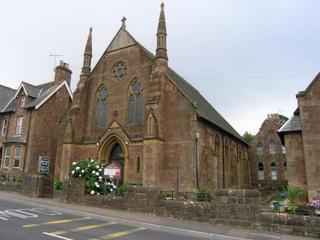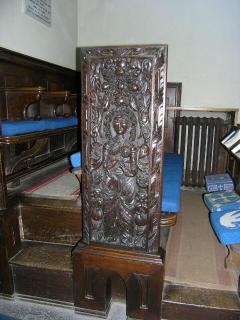The idea for a break here came from our neighbours who have just bought a second home at Williton. In fact as a result we have spent more nights in their house than they have as contracts were not exchanged until the start of September. Speaking to them last night it seems they were a little jealous! We arrived on Sunday and began by just exploring the small rather featureless town, whose best buildings are the former workhouse, splendidly restored into apartments 2004-5, and the police station with a rather silly-looking centrally placed porch tower and flanking domestic looking wings left and right. People were queueing up to put fuel in their cars as threats of a fuel crisis loomed for later in the week thanks to Katrina (government) or Government taxes (protestors) as fuel soared to over GBP1 per litre.
WILLITON METHODIST
 The first church photographed was the Methodist church of 1883, on the Taunton Road leading away from the main street. It is a second pointed Gothic style complex, with a largish chapel and attached minister's house and schoolrooms. The front is divided into three by buttresses which continue up into spindly turrets. The sign proclaimed services at 1030 on Sunday but I thought I would try the door. It opened - and to my horror a service was in place although it was 3.30 in the afternoon! Luckily I did not interrupt the lady minister's flow and shut the door before heads could turn!
The first church photographed was the Methodist church of 1883, on the Taunton Road leading away from the main street. It is a second pointed Gothic style complex, with a largish chapel and attached minister's house and schoolrooms. The front is divided into three by buttresses which continue up into spindly turrets. The sign proclaimed services at 1030 on Sunday but I thought I would try the door. It opened - and to my horror a service was in place although it was 3.30 in the afternoon! Luckily I did not interrupt the lady minister's flow and shut the door before heads could turn!WILLITON ST PETER
The church has to be signposted as it hides away along a quiet cul-de-sac along which is also
 situated The Bakelite Museum. It started as a chapel of ease to St Decuman's Church in Watchet, but at first glance appears to be entirely Victorian (1858 C E Giles). It has a west porch and a bellcote, as well as a rather rogueish (and ugly) north porch. The west porch in fact shelters a Tudor doorway and ancient door, and the windows of the south aisle were reused from the nave when the aisle was added in 1806. Inside the south arcade has roughly cut circular piers and pointed arches, the rest is of 1858, although the east wall of the chancel with its Perp. window is also said to be original. Not much to detain the visitor long inside but the odd font is dated 1666 and is made of local pinkish alabaster from the cliffs at Watchet. Giles apparently removed a medieval stone pulpit and a C15 rood screen, features which the church could use today to add some interest! [open]
situated The Bakelite Museum. It started as a chapel of ease to St Decuman's Church in Watchet, but at first glance appears to be entirely Victorian (1858 C E Giles). It has a west porch and a bellcote, as well as a rather rogueish (and ugly) north porch. The west porch in fact shelters a Tudor doorway and ancient door, and the windows of the south aisle were reused from the nave when the aisle was added in 1806. Inside the south arcade has roughly cut circular piers and pointed arches, the rest is of 1858, although the east wall of the chancel with its Perp. window is also said to be original. Not much to detain the visitor long inside but the odd font is dated 1666 and is made of local pinkish alabaster from the cliffs at Watchet. Giles apparently removed a medieval stone pulpit and a C15 rood screen, features which the church could use today to add some interest! [open]ST GEORGE, SAMPFORD BRETT
 Sometimes a church is visited which is architecturally nothing special, yet embeds itself into your senses so that you never forget it. For me this was one of those churches, a bit of an architectural oddity, a mucked about medieval cruciform church, which is almost as wide as it is long. The tower stands in the position of the south transept, and opposite is a deep north transept with big buttresses to the west. In fact these big buttresses with three set-offs seem to be a feature of the exterior - the chancel has them too - except for the tower which is unbuttressed! The interior preserves several interesting features but it is the embellishments of 1835 which makes the church so special. In fact the interior becomes something of a peice of confectionery, with ornate unexpected plasterwork decoration just like a wedding cake would have around the arches and windows. Yet the roof is C15 and rests on winged putti heads of 1835. The woodwork is classy, many of the bench ends are medieval, but one in particular is probably a little later and is situated at the
Sometimes a church is visited which is architecturally nothing special, yet embeds itself into your senses so that you never forget it. For me this was one of those churches, a bit of an architectural oddity, a mucked about medieval cruciform church, which is almost as wide as it is long. The tower stands in the position of the south transept, and opposite is a deep north transept with big buttresses to the west. In fact these big buttresses with three set-offs seem to be a feature of the exterior - the chancel has them too - except for the tower which is unbuttressed! The interior preserves several interesting features but it is the embellishments of 1835 which makes the church so special. In fact the interior becomes something of a peice of confectionery, with ornate unexpected plasterwork decoration just like a wedding cake would have around the arches and windows. Yet the roof is C15 and rests on winged putti heads of 1835. The woodwork is classy, many of the bench ends are medieval, but one in particular is probably a little later and is situated at the  west end where the pews are raised; it shows an exotic female figure flanked by two female pipers, reputedly recording the legend of Florence Wyndham who, having been placed in her coffin and buried only to then robbed of her rings by a graverobber, awoke from a coma during the robbery, and lived to a ripe old age having several children. (We were to see her monument later at St Decuman, Watchet). What happened to the graverobber goes unrecorded but he surely got a fright! [open]
west end where the pews are raised; it shows an exotic female figure flanked by two female pipers, reputedly recording the legend of Florence Wyndham who, having been placed in her coffin and buried only to then robbed of her rings by a graverobber, awoke from a coma during the robbery, and lived to a ripe old age having several children. (We were to see her monument later at St Decuman, Watchet). What happened to the graverobber goes unrecorded but he surely got a fright! [open]



in The Ecclesiologist (1843) it is revealed that the internal decoration at Sampford Brett is not of plaster but of Watchet alabaster, an interesting alternative use to the alabaster ornaments such as tobacco jars for which Watchet was known as a producer in Victorian times.
ReplyDeleteInteresting!
ReplyDelete